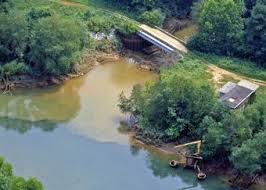
by Bill Schlesinger
For years, doctors have used an analysis of urine, including its color, to help recognize and diagnose certain diseases in humans. Similarly, ecosystem scientists can recognize subtle changes in ecosystems by shifts in the chemical composition and the color of rivers draining them. In both cases, the effluent from a complex system says a lot about how that system is functioning. For example, when you clear-cut a forest, the stream water draining from it often has much higher concentrations of nitrate and other plant nutrients that would be retained if the forest was still growing.
Thus, it is of more than passing interest that an analysis of satellite photos taken during the past 35 years shows a shift in color in more than 1/3 of the rivers draining landscapes in the U.S. In the east, the reflectance of these rivers shifted to yellowish-red wavelengths, indicating a greater load of suspended sediments—not surprising to anyone who has watched the runoff waters from a new suburban housing development. In the west, the reflectance of rivers has shifted to the blue-green end of the spectrum, perhaps as a result of a proliferation of dams that slow the flow of rivers and allow sediments to settle out.
But, there is another facet to the story of river color. Just as the color of lakes changes as a result of algal blooms, so too might we expect shifts in color in rivers if they harbor unusual growth of phytoplankton in their waters. These shifts are probably more difficult to record than similar shifts in lakes, because the turbulence of rivers mixes phytoplankton in their waters, so that thick blooms are not as easily observed. In this case, the color of rivers seen from space may provide a better index of the health of rivers than simple visual observations from land. Shifts to the blue-green end of the spectrum indicate greater phytoplankton abundance.
And why the shifts in phytoplankton abundance? Many rivers now carry higher loads of nitrate and phosphate than they did a few decades ago, as a result of the fertilization of agricultural land, the runoff from livestock operations, and the effluent of sewage treatment plants that don’t always remove the soluble constituents. The Mississippi River carries 140% more nitrate than it did 100 years ago, and its nutrient content is directly related to algal blooms in the Gulf of Mexico. In the northeastern U.S., some rivers have lower concentrations of nitrate in recent collections, perhaps explaining their shift away from the blue-green wavelengths. Agriculture is not the predominant land use in this region, which is cleared for development.
And why should you care? Sport fishermen will immediately recognize the implications of this work, especially for rivers where the reflectance is increasingly yellow, indicating sediment transport. Those charged with providing healthy drinking water for humans should note, with some alarm, shifts to the blue-green end of the spectrum, that may reflect harmful algal blooms. Such a bloom rendered the water in Toledo, Ohio unfit for human consumption.
All of us should note that even from space, we can see that the effluent from large regions has changed, which, like a urine specimen, may indicate a shift to unhealthy conditions in the ecosystems they harbor.
References
Gardner, J.R. and 5 others. 2021. The color of rivers. Geophysical Research Letters doi: 10.1029/2020GL088946
Tian, H., and 11 others. 2020. Long-term trajectory of nitrogen loading and delivery from Mississippi River basin to the Gulf of Mexico. Global Biogeochemical Cycles doi: 10.1029/2019GB006475
Turner, R.E. and N.N. Rabalais. 1991. Changes in Mississippi River water quality this century. Bioscience 41: 140-147